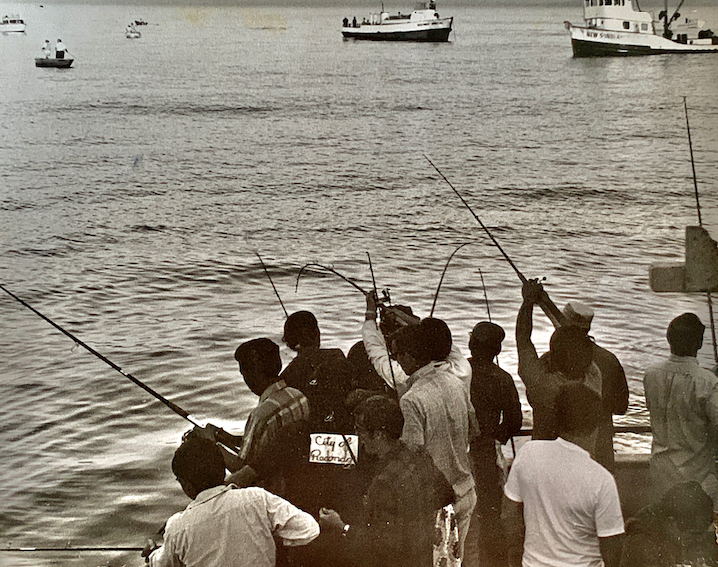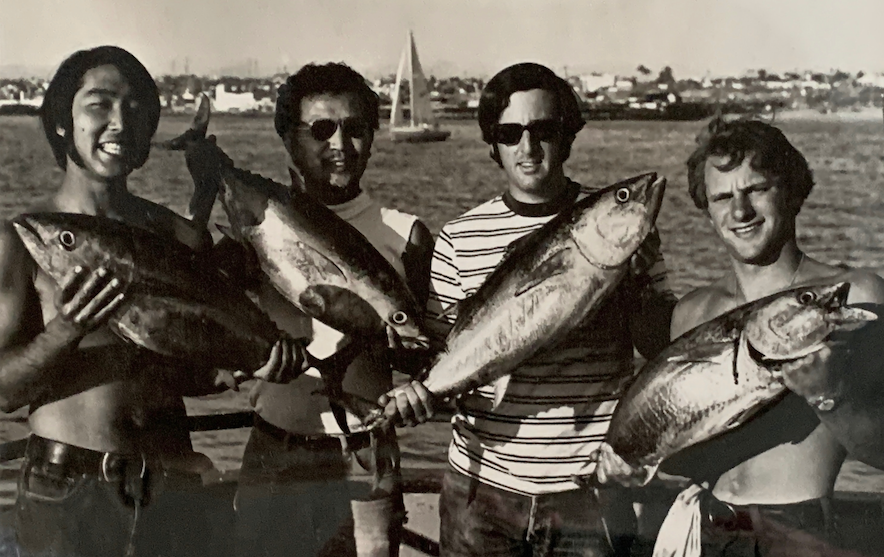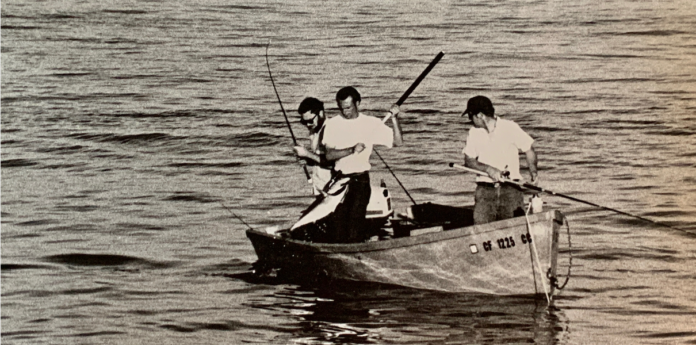
BY JON DICKENS
It hasn’t been a good time to be a boss of late. Especially if your employees like to fish. And even more so if they like to fish for tuna.
“Boss, I can’t make it into work today. My back went out again.” As in, back went out to the tuna grounds. Or maybe the call is, “Hey boss, can’t make in today. I have a fever, and it’s highly contagious.” Yeah, tuna fever.
These “illnesses” are nothing new — they’ve been around for decades. And in case you thought the bluefin tuna we’re seeing pop up offshore from Mexican waters to the outer islands, and even in local inshore waters for the last several years is something new, they were also around decades ago. However, unless you’re of a certain age, many anglers aren’t aware of the local bluefin bites that occurred back in the 1960s and 1970s in Santa Monica Bay.
They weren’t the behemoths that are showing up now, but about this time during some of those years in that era, 12- to 25-pound footballs showed up with regularity at the Redondo Canyon, a scant half-mile from the beach. Really.
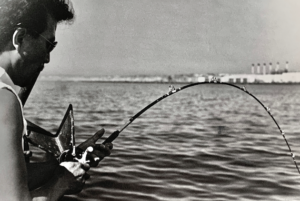
BENDO! – It took parabolic rods to toss a pinhead anchovy on 12-pound mono and number 8 hooks for bluefin. This picture shows how close to King Harbor the fish were, with the Southern California Edison Plant stacks in the background.
This submarine canyon is so close to the beach that you can be fishing for halibut over a sandy bottom on one drift, and then if you start your next drift a little deeper, you can suddenly find yourself in water that goes to 600 feet, and eventually 2,000 feet deep. Back in the day, it might be holding rockfish suspended along the ledges, or tuna and even salmon from 150 feet up to the surface mixed with jumbo bonito in the 8- to 12-pound class. And to top it all off, the spot is only about a 15-minute ride from the Redondo Beach Pier and the Redondo Sportfishing fleet.
Back in the day, I was one of the kids that fished the half-day boats from Redondo whenever I could. My favorite was the City of Redondo run by Roy Peters, with his wife Doris in the galley. I also fished with Glenn Mueller on the Redondo Special and a number of the 3/4-day boats from that landing, including the Mascot IV with Joe Schilling at the helm.
A lot of the crew on those boats moved on to other boats as they worked their way up the ladder. One of the pinheads I fished with at that time was a hot stick named Rick Oefinger. His passion for fishing led him to becoming a deckhand, captain and now the owner of several sportboats and Marina del Rey Sportfishing. I guess he’s done ok. (For a fun read on the boats and crews during the bluefin runs of yesteryear, check out some of the Redondo Bluefin threads on www.allcoast.com)
Bluefin on old school tackle
When the bluefin showed up, fishing for them was considerably different than how it’s done today. No Madmacs, no flying fish on kites, no spreader bars. No braid or fluorocarbon in those days, either. No two-speed reels, or reels that just consistently functioned well by today’s standards. The reels of choice were the Penn 25, 100 Surfmaster, Squidder and Squidder Jr., and the Jigmaster and Jigmaster Jr. Another rare reel that Jerry Morris of Jerry’s Tackle Box used to sell was the Alvey from Australia, a big-spooled side cast spinner of sorts. It could cast a mile for those that knew how to use them, and I remember a guy even using them for the tuna.
The Penn reels mentioned above came with plastic spools and some could be upgraded
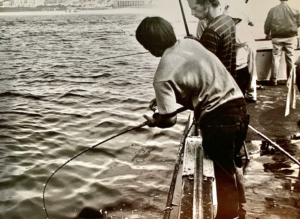
with metal spools, but you sacrificed casting distance because the spools didn’t spin as freely as the plastic spools. The plastic spools had their own problems though. Many didn’t fit properly within the side plates, leaving slight gaps that would snag and nick your monofilament line.
The common remedy was to figure out where the gaps were and brush on layers of clear nail polish to make them fit better. Sometimes it worked, sometimes it didn’t. The other problem was the plastic spools, even with Dacron or masking tape backing, tended to buckle under pressure and blow up on you.
To throw the anchovies, the rods tended to be lightweight and fairly parabolic. The Sabre 196 and 220, along with the Truline 4x, lighter weight Roddys and Fenwicks were popular ones. My light-line outfit back then was a 6 1/2-foot custom Roddy that bent like a twig with a Penn 25 clamped onto it with 12-pound Meslon mono. I still have it.
When the tuna moved in, things got really crazy. In addition to the party boats, you’d see everything from 14-foot skiffs to the New Sunbeam bait boat drifting over the Tuna Spot on the canyon or chasing breezers that popped up. The fish were always spooky and our bait was mostly pinhead ‘chovies, not much more than two eyes and a wiggle. You couldn’t buy
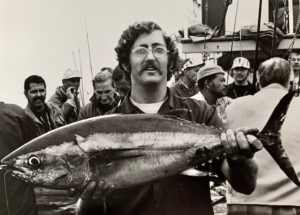
a bite on 15-pound mono. It usually took 12-pound or even 10-pound to get bit. Meslon was the hot mono line for those in the know and it was available at Lincoln Pico Sporting Goods in Santa Monica.
It was soft and thin and you’d have to change it every couple trips, but it was cheap and seemed to get bit better than the other brands. Couple that with a number 8 hook and you were in business. As usual, it took the hottest green-backed anchovy in the tank to get bit and the percentage of hookups to landed fish was understandably low.
Floating sushi bar
On those trips, it was mostly the young guns and top tier anglers fishing for the tuna, while the rest fished for rockfish or depending on where the skipper set up, maybe some barracuda or bass on heavier setups. The tuna would roll through and several guys with the light line would hook up and start their laps around the boat.
Not easy to keep your fish in front of you when there were 70 people on the boat and some of the old guys didn’t want to move off their numbered spot to let you through. Casualties were high but there were usually a handful or two landed per trip when the tuna showed, unless you were lucky enough to be out when they went bonkers and there could be 80 fish on the boat.
The bluefin were even occasionally caught off the Sacramento and California fishing barges anchored not far from there and a few were reportedly hooked from the old Monstad Pier. They also popped up occasionally at nearby spots like The Crane, The Buccaneer and Haggerty’s Cove when chumming for bonito.
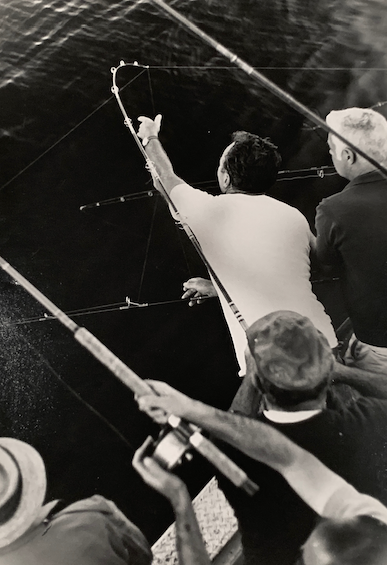
In a few of those bluefin years, salmon also filtered through the canyon and showed up with the bluefin. I didn’t get to experience it but I heard from many people that there were days where one guy was fighting a bluefin, and the guy next to him would be on a salmon. Talk about strange bedfellows. Sounds like a floating sushi bar. Bluefin and salmon on the same half-day trip? Doubt we’ll ever see that again.
Years later, in the ‘80s, there was a three-day bite on 25- to 50-pound bluefin up around Sunset Beach and the Topanga Bubbles that was kept under wraps and only the “regulars” knew of. I can’t remember if it was the original Del Mar or Happy Man (now the Native Sun) that had the fish to themselves. I got out the third day of the bite and went through several fish before landing a little 25 pounder on 12-pound mono and a number 8 hook.
The pinhead anchovies would form a meatball and hide under the boat and every once in a while Captain Branny Ford would fire up the engines to kick them out and the tuna would absolutely maul them. I remember wishing I had a video camera to record the mayhem as big tuna cleared the water and put on quite the show. We didn’t see foamers like we do now showing up in the bay in those days. Just watching was worth the price of admission.
Déjà vu all over again?
Fast forward to the present. Bluefin have been seen frothing again in the outer reaches of Santa Monica Bay recently. And, is often the case, many were not prepared for the battle, but a number have been landed, including a 178-pound giant just four miles south of the harbor at Marina Del Rey. According to Dave Wilks and Danny Moenaert aboard the False
Alarm, they were making squid at night to fish for seabass this past June. With lines in the water “just in case,” the clicker goes off at 4:30 a.m. and what they thought was a big black seabass turned into a monster bluefin that apparently got lost.
While that’s a rarity, could those football-sized bluefin be back at Redondo Canyon? I wonder if anyone’s fished there of late. Meanwhile, I hope you enjoy the old black and white photos of that special time and they bring back fond memories for some of you old salts. Are we heading back to the future? Maybe it will happen again. This season, anything’s possible.
